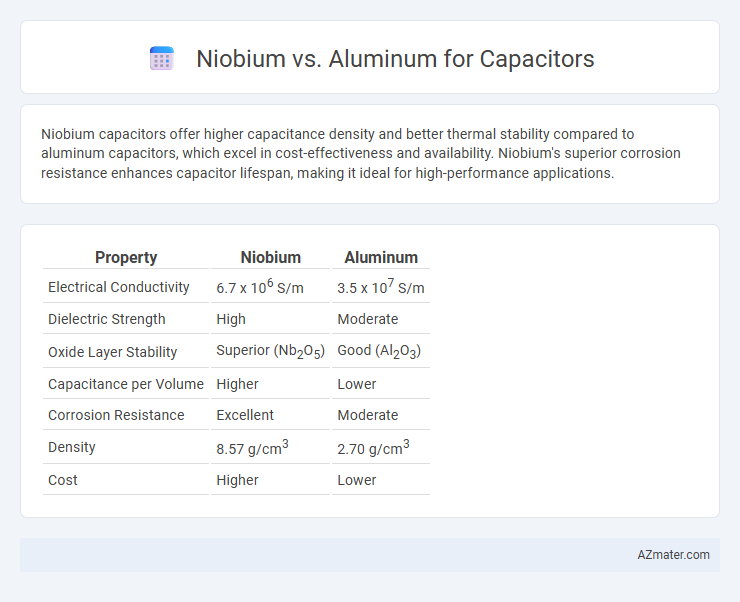Niobium capacitors offer higher capacitance density and better thermal stability compared to aluminum capacitors, which excel in cost-effectiveness and availability. Niobium's superior corrosion resistance enhances capacitor lifespan, making it ideal for high-performance applications.
Table of Comparison
| Property | Niobium | Aluminum |
|---|---|---|
| Electrical Conductivity | 6.7 x 106 S/m | 3.5 x 107 S/m |
| Dielectric Strength | High | Moderate |
| Oxide Layer Stability | Superior (Nb2O5) | Good (Al2O3) |
| Capacitance per Volume | Higher | Lower |
| Corrosion Resistance | Excellent | Moderate |
| Density | 8.57 g/cm3 | 2.70 g/cm3 |
| Cost | Higher | Lower |
Introduction to Niobium and Aluminum Capacitors
Niobium capacitors utilize niobium pentoxide as the dielectric material, offering higher volumetric efficiency and improved electrolyte stability compared to traditional aluminum capacitors, which employ aluminum oxide dielectrics. Aluminum capacitors are widely used for their cost-effectiveness, large capacitance values, and established manufacturing processes, but they often suffer from limited voltage ratings and shorter lifespans under high-temperature conditions. Niobium capacitors provide enhanced performance in compact electronic devices by combining stability, longer service life, and better tolerance to voltage spikes, positioning them as a competitive alternative in advanced applications.
Material Properties: Niobium vs Aluminum
Niobium offers higher dielectric constant and better corrosion resistance compared to aluminum, enhancing capacitor performance and longevity. Niobium capacitors exhibit superior thermal stability and maintain capacitance at elevated temperatures, unlike aluminum which suffers from higher leakage currents and lower conductivity. The material's ability to form a stable oxide layer contributes to niobium's advantage in applications requiring high reliability and compact designs.
Capacitance Characteristics Comparison
Niobium capacitors exhibit higher volumetric capacitance and improved temperature stability compared to aluminum capacitors, making them suitable for miniaturized designs and harsh environments. The dielectric oxide layer in niobium capacitors provides better leakage current control and lower equivalent series resistance (ESR) than aluminum oxide dielectrics, enhancing overall performance. While aluminum capacitors offer cost advantages and wider availability, niobium capacitors deliver superior capacitance retention at high frequencies and elevated temperatures.
ESR and Ripple Current Performance
Niobium capacitors exhibit lower Equivalent Series Resistance (ESR) compared to aluminum capacitors, which reduces power losses and heat generation during operation. Their enhanced ripple current handling capability stems from superior conductivity and better thermal stability, enabling higher performance in high-frequency applications. Aluminum capacitors, while cost-effective, typically demonstrate higher ESR and limited ripple current endurance, making niobium capacitors preferable for demanding electronic circuits requiring efficient energy management.
Size and Form Factor Differences
Niobium capacitors offer a higher volumetric efficiency compared to aluminum capacitors, enabling smaller size and more compact form factors in electronic devices. The intrinsic properties of niobium allow for thinner oxide layers and higher capacitance per unit volume, resulting in reduced footprint without compromising performance. In contrast, aluminum capacitors typically require larger physical dimensions to achieve similar capacitance values, impacting circuit miniaturization.
Reliability and Lifespan Considerations
Niobium capacitors exhibit superior reliability and longer lifespan compared to aluminum capacitors due to their stable oxide layer, which enhances resistance to corrosion and thermal degradation. The Nb2O5 dielectric in niobium capacitors offers higher dielectric strength, resulting in improved performance under high voltage and elevated temperature conditions. Aluminum capacitors, while cost-effective, tend to experience dielectric breakdown and electrolyte evaporation faster, reducing their overall operational lifespan.
Cost and Availability Analysis
Niobium capacitors generally exhibit higher initial costs compared to aluminum capacitors due to the rarity and complex extraction processes of niobium, impacting overall material expenses. Aluminum capacitors benefit from widespread availability and mature manufacturing infrastructure, resulting in lower price points and extensive market supply. Cost-efficiency and accessibility make aluminum capacitors favorable for mass production, while niobium capacitors justify their premium pricing through superior performance in specialized applications.
Typical Applications for Each Material
Niobium capacitors are typically used in aerospace, military, and high-reliability medical devices due to their excellent stability, high capacitance, and superior temperature tolerance. Aluminum capacitors find widespread applications in consumer electronics, power supplies, and automotive systems, benefiting from their cost-effectiveness and high availability. Each material's unique properties dictate its suitability for specific environments, with niobium excelling in demanding, high-performance scenarios and aluminum favored for general-purpose, cost-sensitive applications.
Environmental and Safety Aspects
Niobium capacitors exhibit superior environmental benefits due to niobium's abundance and lower toxicity compared to aluminum, which often requires energy-intensive refining and generates significant waste. Niobium's stable oxide layer reduces the risk of capacitor failure and hazardous leaks, enhancing safety in electronic applications. Aluminum capacitors tend to have higher environmental footprints and safety concerns due to their volatile electrolyte solvents and susceptibility to corrosion.
Conclusion: Selecting the Right Capacitor Material
Niobium capacitors offer higher volumetric efficiency, enhanced stability, and better performance at elevated temperatures compared to aluminum capacitors, making them ideal for compact, high-reliability applications. Aluminum capacitors provide cost-effective solutions with wide availability and excellent conductivity but may suffer from shorter lifespans and lower performance under extreme conditions. Selecting the right capacitor material depends on specific requirements such as durability, temperature tolerance, and budget constraints, with niobium favored for advanced electronics and aluminum suited for general-purpose uses.

Infographic: Niobium vs Aluminum for Capacitor
 azmater.com
azmater.com